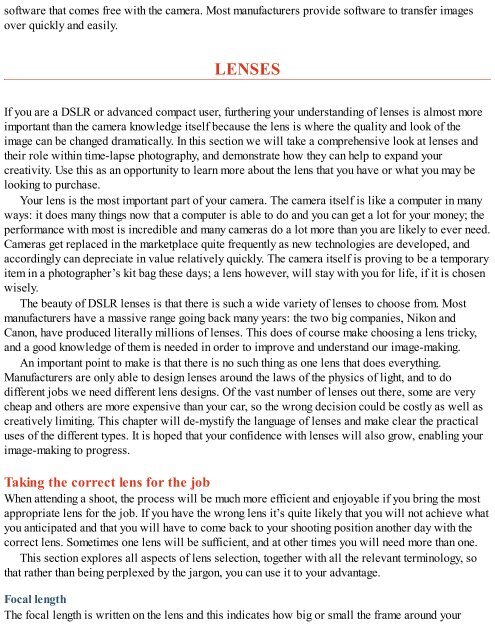Time-Lapse Photography Art and Techniques by Mark Higgins
Create successful ePaper yourself
Turn your PDF publications into a flip-book with our unique Google optimized e-Paper software.
software that comes free with the camera. Most manufacturers provide software to transfer images<br />
over quickly <strong>and</strong> easily.<br />
LENSES<br />
If you are a DSLR or advanced compact user, furthering your underst<strong>and</strong>ing of lenses is almost more<br />
important than the camera knowledge itself because the lens is where the quality <strong>and</strong> look of the<br />
image can be changed dramatically. In this section we will take a comprehensive look at lenses <strong>and</strong><br />
their role within time-lapse photography, <strong>and</strong> demonstrate how they can help to exp<strong>and</strong> your<br />
creativity. Use this as an opportunity to learn more about the lens that you have or what you may be<br />
looking to purchase.<br />
Your lens is the most important part of your camera. The camera itself is like a computer in many<br />
ways: it does many things now that a computer is able to do <strong>and</strong> you can get a lot for your money; the<br />
performance with most is incredible <strong>and</strong> many cameras do a lot more than you are likely to ever need.<br />
Cameras get replaced in the marketplace quite frequently as new technologies are developed, <strong>and</strong><br />
accordingly can depreciate in value relatively quickly. The camera itself is proving to be a temporary<br />
item in a photographer’s kit bag these days; a lens however, will stay with you for life, if it is chosen<br />
wisely.<br />
The beauty of DSLR lenses is that there is such a wide variety of lenses to choose from. Most<br />
manufacturers have a massive range going back many years: the two big companies, Nikon <strong>and</strong><br />
Canon, have produced literally millions of lenses. This does of course make choosing a lens tricky,<br />
<strong>and</strong> a good knowledge of them is needed in order to improve <strong>and</strong> underst<strong>and</strong> our image-making.<br />
An important point to make is that there is no such thing as one lens that does everything.<br />
Manufacturers are only able to design lenses around the laws of the physics of light, <strong>and</strong> to do<br />
different jobs we need different lens designs. Of the vast number of lenses out there, some are very<br />
cheap <strong>and</strong> others are more expensive than your car, so the wrong decision could be costly as well as<br />
creatively limiting. This chapter will de-mystify the language of lenses <strong>and</strong> make clear the practical<br />
uses of the different types. It is hoped that your confidence with lenses will also grow, enabling your<br />
image-making to progress.<br />
Taking the correct lens for the job<br />
When attending a shoot, the process will be much more efficient <strong>and</strong> enjoyable if you bring the most<br />
appropriate lens for the job. If you have the wrong lens it’s quite likely that you will not achieve what<br />
you anticipated <strong>and</strong> that you will have to come back to your shooting position another day with the<br />
correct lens. Sometimes one lens will be sufficient, <strong>and</strong> at other times you will need more than one.<br />
This section explores all aspects of lens selection, together with all the relevant terminology, so<br />
that rather than being perplexed <strong>by</strong> the jargon, you can use it to your advantage.<br />
Focal length<br />
The focal length is written on the lens <strong>and</strong> this indicates how big or small the frame around your

















